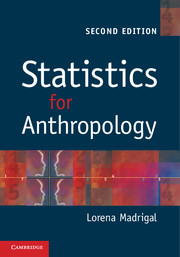Book contents
- Frontmatter
- Contents
- List of partial statistical tables
- Preface
- 1 Introduction to statistics and simple descriptive statistics
- 2 The first step in data analysis
- 3 Probability and statistics
- 4 Hypothesis testing and estimation
- 5 The difference between two means
- 6 The analysis of variance (ANOVA)
- 7 Non-parametric tests for the comparison of samples
- 8 The analysis of frequencies
- 9 Correlation analysis
- 10 Simple linear regression
- 11 Advanced topics in regression analysis
- References
- Index
6 - The analysis of variance (ANOVA)
Published online by Cambridge University Press: 05 June 2012
- Frontmatter
- Contents
- List of partial statistical tables
- Preface
- 1 Introduction to statistics and simple descriptive statistics
- 2 The first step in data analysis
- 3 Probability and statistics
- 4 Hypothesis testing and estimation
- 5 The difference between two means
- 6 The analysis of variance (ANOVA)
- 7 Non-parametric tests for the comparison of samples
- 8 The analysis of frequencies
- 9 Correlation analysis
- 10 Simple linear regression
- 11 Advanced topics in regression analysis
- References
- Index
Summary
In this chapter we deal with a fundamentally important technique to analyze experimental data. The analysis of variance (ANOVA from now on) is due to Fisher (in whose honor the F distribution – used to test the ANOVA's H0) is so named (Fisher 1993; Zabell 2001). In experimental, lab-based fields, in which researchers have much control over experimental and control groups, the applications of ANOVA are almost endless. It is for this reason that textbooks written for biology and psychology students include exhaustive chapters on many ANOVA designs (Pagano and Gauvreau 1993; Rosner 2006; Sokal and Rohlf 1995; Zar 1999). In anthropology we are more limited by the fact that we are unable to control with much precision different levels of the independent variable and have (in general) less control over our experiment. My treatment of ANOVA is thus rather limited when compared with textbooks in biology, psychology, or public health.
Model I and model II ANOVA
It is easy for students to be overwhelmed when they read that there are model I, model II, and mixed-model, and one-way and two-way ANOVAs. Let us clarify what models I and II are. Mixed-model ANOVAS will be discussed when we cover two-way ANOVAs, in section 6.5. The experimental design of a model I ANOVA is similar to that of an un-paired t test. Indeed, I mentioned that the t test should be understood as a special form of the analysis of variance. In a one-way ANOVA we have more than two groups which have been subjected to different levels of the treatment. As we did for the t test, let us think of analysis of variance in terms of dependent (Y) and independent (X) variables. The dependent variable is that whose behavior we want to study such as the number of calories consumed by children. The dependent variable (Y) is usually a continuous numeric variable or a discontinuous numeric variable with a broad range of possible outcomes.
- Type
- Chapter
- Information
- Statistics for Anthropology , pp. 122 - 145Publisher: Cambridge University PressPrint publication year: 2012



